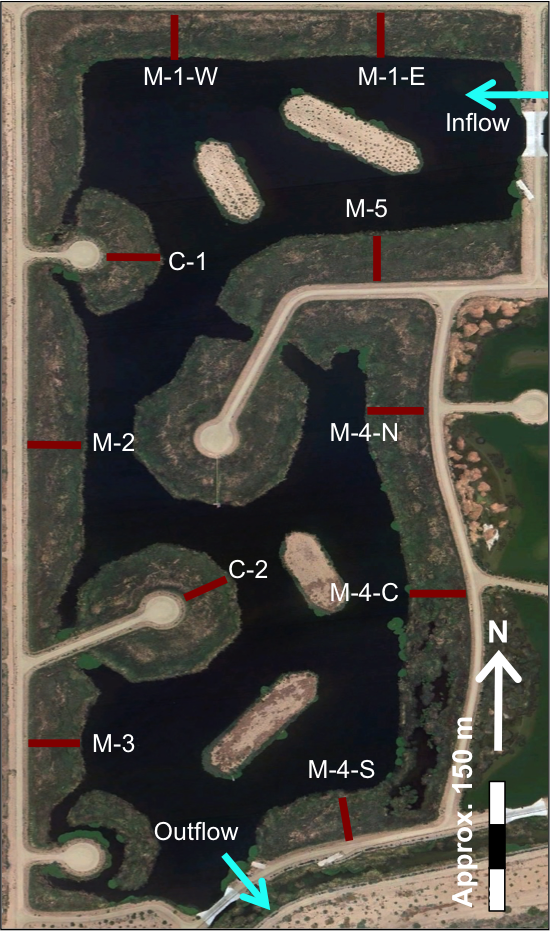Tres Rios Wetland Dynamics
Overview

To enhance our understanding of the water, nutrient, and ultimately treatment dynamics of constructed treatment wetlands in aridland, urban environments, the Central Arizona–Phoenix Long-Term Ecological Research (CAP LTER) program is developing robust water and nutrient budgets for the Tres Rios constructed wetland in Phoenix, AZ USA. Completed in 2010 and operated by the City of Phoenix Water Services Department, the Tres Rios Wetlands are a tertiary wastewater treatment facility associated with the City of Phoenix’s 91st Avenue Waste Water Treatment Plant—the largest municipal treatment plant in Phoenix. Water inflows from the treatment plant to the Tres Rios wetlands varies seasonally from 95,000 to over 270,000 m3 d-1. Water losses via open water evaporation and plant transpiration are several orders of magnitude higher than annual precipitation inputs in Phoenix. A main goal of our research is to understand how these high rates of water losses to the atmosphere affect the water and nutrient budgets of the wetland ecosystem, and potentially affect the services it can provide.
The Wetland Ecosystem Ecology Lab group, which is part of CAP, began monitoring the Tres Rios wetlands in Summer 2011. Approximately 42 ha in total area, this wetland system is composed nearly equally of large open-water areas (21 ha) and a fringing vegetated marsh (21 ha). Measurements and samples are taken along two gradients representing the two hydraulic pathways of the treatment cell: whole-system, from inflow to outflow, and within the vegetated marsh proper, from the open water-marsh interface to the shoreline. We use a nutrient budget approach to determine inorganic nitrogen (N) removal by the entire system and the vegetated marsh, and a water budget approach to determine the proportional contribution of atmospheric water losses via transpiration and evaporation to the whole system water budget. Initial results from the first five years of study suggest that plant transpiration, particularly during the hot, dry summer months, is a large enough water loss that it is driving a lateral flow of surface water from open water areas into the vegetated marsh. We call this phenomenon a “biological tide” and note that this kind of plant-mediated control of surface hydrology in a wetland has never before been documented. By bringing new nitrogen into the marsh, this “biological tide” is actually making the Tres Rios wetland more efficient at nutrient removal than similar in cooler or more mesic climates. Please refer to Sanchez et al. (2016) and Weller et al. (2016.) for details of methods and additional results of this project.
Datasets
Long-term monitoring and research of the ecology of the Tres Rios constructed treatment wetland, Phoenix, AZ, ongoing since 2011Publications
Bois, P., D. L. Childers, T. Corlouer, J. Laurent, A. Massicot, C. A. Sanchez and A. Wanko. 2017. Confirming a plant-mediated "Biological Tide" in an aridland constructed treatment wetland. Ecosphere 8(3):e01756. DOI: 10.1002/ecs2.1756. (link )
Weller, N. A., D. L. Childers, C. A. Sanchez, L. J. Turnbull and R. F. Upham. 2016. Aridland constructed treatment wetlands I: Macrophyte community productivity, community composition, and nitrogen uptake. Ecological Engineering 97(Dec):649=657. DOI: 10.1016/j.ecoleng.2015.05.044. (link )
Sanchez, C. A., D. L. Childers, L. J. Turnbull, R. F. Upham and N. A. Weller. 2016. Aridland constructed treatment wetlands II: Plant mediation of surface hydrology enhances nitrogen removal. Ecological Engineering 97(Dec):658-665. DOI: 10.1016/j.ecoleng.2016.01.002. (link )

